Student & Alumni Work
Recent Updates
Epistemological Disobedience
Jacqueline Cofield, Ed.D candidate - Curriculum & Teaching
"Epistemic disobedience means to delink from the zero point epistemology. Epistemic disobedience, which Walter Mignolo talks about in his books, recognizes that all knowledges are situated, and involves decolonial delinking from geopolitics of knowing that center and privelege historical, political, and ethical considerations and enunciations promoted by western and eurocentric epistemes...This is a visual representation of my epistemic disobedience."
More Than a Feeling: Exploring the Affective Entanglements of Meaning-Making at Sites of Difficult History
Allison Weller, Ph.D candidate - Teaching of Social Studies
More Than a Feeling: Exploring the Affective Entanglements of Meaning-Making at Sites of Difficult History
Allison Weller, Ph.D candidate - Teaching of Social Studies
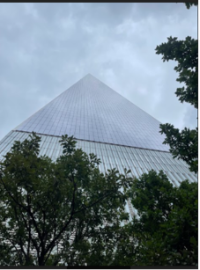 Within social studies and heritage education, the affective turn has led to an increased interest in sites of difficult history. Although there is a plethora of cross-disciplinary theoretical research that suggests affect plays a significant role in meaning-making in these spaces, there are few empirical studies that examine this assumption. Moreover, the empirical studies that do exist tend to focus on student experiences in these spaces, seemingly excluding the important consideration of how teachers construct meaning through affective engagement and practices. As many teachers seek out heritage sites to better their pedagogical preparation to teach difficult histories, it is necessary to further understand their experiences in these spaces, as this can provide insight into how historical narratives and heritage are constructed and passed on.
Within social studies and heritage education, the affective turn has led to an increased interest in sites of difficult history. Although there is a plethora of cross-disciplinary theoretical research that suggests affect plays a significant role in meaning-making in these spaces, there are few empirical studies that examine this assumption. Moreover, the empirical studies that do exist tend to focus on student experiences in these spaces, seemingly excluding the important consideration of how teachers construct meaning through affective engagement and practices. As many teachers seek out heritage sites to better their pedagogical preparation to teach difficult histories, it is necessary to further understand their experiences in these spaces, as this can provide insight into how historical narratives and heritage are constructed and passed on.
Utilizing semi-structure interviews, photo-elicitation, and sensory ethnographic place-making methodologies, this dissertation conceptualizes the affective meaning-making processes that three teachers engaged in during their encounters with the National September 11th Memorial Museum (NS11MM). Categorized as emotions, memory, historical proximity, and authenticity, these affective meaning-making processes deeply impacted what three high school social studies 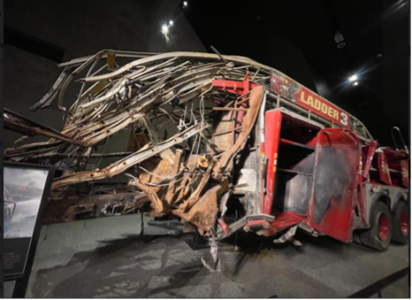 teachers took away from their visits to the National September 11th Memorial Museum (NS11MM), resulting in a decentered, patriotic perspective grounded in American exceptionalism, innocence, and unity. Understanding the affective entanglements of the three teachers in their encounters with the NS11MM provides insight into how meaning, understood as historical understanding and significance, is constructed at sites of difficult history.
teachers took away from their visits to the National September 11th Memorial Museum (NS11MM), resulting in a decentered, patriotic perspective grounded in American exceptionalism, innocence, and unity. Understanding the affective entanglements of the three teachers in their encounters with the NS11MM provides insight into how meaning, understood as historical understanding and significance, is constructed at sites of difficult history.
"Within social studies and heritage education, the affective turn has led to an increased interest in sites of difficult history...this dissertation conceptualizes the affective meaning-making processes that three teachers engaged in during their encounters with the National September 11th Memorial Museum (NS11MM)."
Chaos Theory = Creativity
Susan Pope, Ed.D candidate - Dance Education
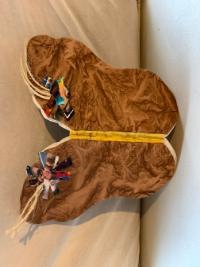 The intersection of my lived experiences with chaos theory led me to explore the implications for education as a way to develop creativity using a framework for embodied learning. While chaos theory was originally theorized as a mathematical concept; I looked at chaos theory from the perspective of Native Science (Cajete, 2004) and Ubuntu philosophy (Ramose, 2004). Both philosophies believe order and creativity are the offspring of chaos and the generative forces of the universe. The philosophy of Native Science is rooted in the need to make meaning of life and understand everyone’s life journey. People are co-creators with nature seeking to live in harmony not seeking to control (Cajete, 2004). Ubuntu philosophy is the basic belief that I am because we are. Ubuntu means love, truth, peace, happiness, eternal optimism, and inner goodness. It is the actualization of the search for humanity within others, within our communities, and within the action. Ubuntu values family life, elders, and nature. There is a consistent search for becoming. Most beneficial to the field of pedagogy are its implications for the classroom. Embodied pedagogy involves the role of the body as a locus of learning. Used often in dance education but less often in general education, “embodied learning signifies an epistemological and pedagogic shift and draws attention to bodies as agents of knowledge production” (Wilcox, 2009, as cited in Wagner & Shahjahan, 2015, p. 245).
The intersection of my lived experiences with chaos theory led me to explore the implications for education as a way to develop creativity using a framework for embodied learning. While chaos theory was originally theorized as a mathematical concept; I looked at chaos theory from the perspective of Native Science (Cajete, 2004) and Ubuntu philosophy (Ramose, 2004). Both philosophies believe order and creativity are the offspring of chaos and the generative forces of the universe. The philosophy of Native Science is rooted in the need to make meaning of life and understand everyone’s life journey. People are co-creators with nature seeking to live in harmony not seeking to control (Cajete, 2004). Ubuntu philosophy is the basic belief that I am because we are. Ubuntu means love, truth, peace, happiness, eternal optimism, and inner goodness. It is the actualization of the search for humanity within others, within our communities, and within the action. Ubuntu values family life, elders, and nature. There is a consistent search for becoming. Most beneficial to the field of pedagogy are its implications for the classroom. Embodied pedagogy involves the role of the body as a locus of learning. Used often in dance education but less often in general education, “embodied learning signifies an epistemological and pedagogic shift and draws attention to bodies as agents of knowledge production” (Wilcox, 2009, as cited in Wagner & Shahjahan, 2015, p. 245).
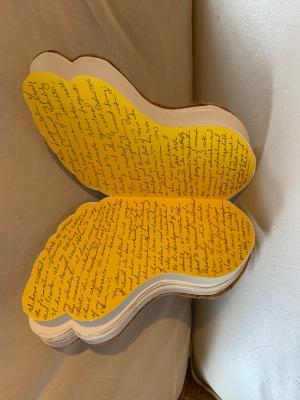 I created a foot book to analyze data and explore my positionality. The image of the foot represents our bodies and how just one part of our body can have a profound effect on our lives. The shape of a foot also represents my transformational leadership style, which builds from the bottom up (Hallinger, 2003). The foot shape also represents interoception as the sense of what is going on inside the body (Shonstrom, 2020). My book transforms into a butterfly which represents chaos theory, the butterfly effect, transformation, and the fragility of research. In chaotic systems, even small things turn out to have large-scale effects over time. Cajete (2021) tells us “Human butterfly power resides in our ability to create” (p. 252). The fragments of pictures represent my positionality and intersections of my
I created a foot book to analyze data and explore my positionality. The image of the foot represents our bodies and how just one part of our body can have a profound effect on our lives. The shape of a foot also represents my transformational leadership style, which builds from the bottom up (Hallinger, 2003). The foot shape also represents interoception as the sense of what is going on inside the body (Shonstrom, 2020). My book transforms into a butterfly which represents chaos theory, the butterfly effect, transformation, and the fragility of research. In chaotic systems, even small things turn out to have large-scale effects over time. Cajete (2021) tells us “Human butterfly power resides in our ability to create” (p. 252). The fragments of pictures represent my positionality and intersections of my 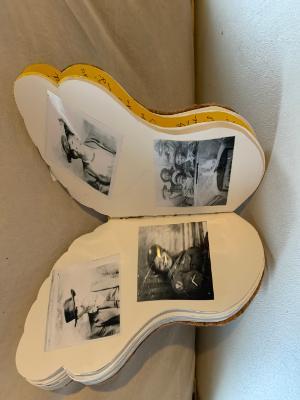 identities as a Black woman, educator, liturgical dancer, caretaker, mother, and advocate. These fragments also point to my spiritual self as identified with Psalm 139:13, “For you created my inmost being you knit me together in my mother’s womb” and Romans 10:15, “How can anyone preach unless they are sent? As it is written: “How beautiful are the feet of those who bring good news” (The Holy Bible, new international version, 1984). As a researcher, I envision an educational system that is equitable. I realize all my research is subject to the delicate changes in our society. I must not only collect and analyze data but be sensitive to it and interact with it to effect change. I recognize and celebrate the practices which have existed in our indigenous and neo-indigenous communities of practice for years (Emdin, 2016).
identities as a Black woman, educator, liturgical dancer, caretaker, mother, and advocate. These fragments also point to my spiritual self as identified with Psalm 139:13, “For you created my inmost being you knit me together in my mother’s womb” and Romans 10:15, “How can anyone preach unless they are sent? As it is written: “How beautiful are the feet of those who bring good news” (The Holy Bible, new international version, 1984). As a researcher, I envision an educational system that is equitable. I realize all my research is subject to the delicate changes in our society. I must not only collect and analyze data but be sensitive to it and interact with it to effect change. I recognize and celebrate the practices which have existed in our indigenous and neo-indigenous communities of practice for years (Emdin, 2016).
As educators, as human beings, we do not need to look for chaos. It exists in our everyday lives; it exists in our classroom. The challenge is to trust ourselves enough to embark on a journey towards being. This journey, filled with “the unpredictability and relative randomness of the creative process” will naturally emerge (Cajete, 2004, p. 48). Even the late congressman John Lewis understood the power of embodiment in times of chaos.
When you pray move your feet (African proverb)
as a nation, if we care for the
beloved community we must move our feet,
our hands, our hearts, our resources to build
a way to tear down to reconcile, not to divide to love
and not to hate to heal and not to kill.
In the final analysis we are one people, one family,
One house, the American house, the American people.
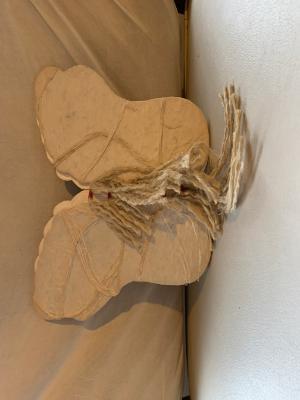
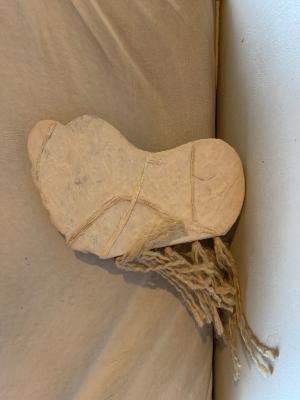
References
Cajete, G. (2004). Philosophy of Native Science. In A. Waters (Author), American Indian Thought: Philosophical essays(pp. 45-57). Blackwell.
Cajete, G. (2021). Western science and the loss of natural creativity. In Unlearning the language of conquest: Scholars expose anti-Indianism in America (pp. 247–259). University of Texas Press. https://doi.org/10.7560/706545-021
Emdin, C. (2016). For White Folks Who Teach in the Hood... and The Rest of Y’all Too: Reality Pedagogy and Urban Education. Beacon Press.
Hallinger, P. (2003). Leading educational change: Reflections on the practice of instructional and transformational leadership. Cambridge Journal of Education, 33(3), 329-352.
Ramose, M. B. (2004). Ubuntu Philosophy. In P. H. Coetzee & A. P. Roux (Authors), The African philosophy reader: A text with readings (pp. 270-280). Routledge. https://doi.org/10.4324/9780203493229.
Shonstrom, E. (2020). The wisdom of the body: what embodied cognition can teach us about learning, human development, and ourselves. Rowman & Littlefield.
The Holy Bible, new international version, (1984), Grand Rapids: Zondervan Publishing House.
Wagner, A. E., & Shahjahan, R. A. (2015). Centering embodied learning in anti-oppressive pedagogy. Teaching in Higher Education, 20(3), 244-254. doi:10.1080/13562517.2014.993963
"I created a foot book to analyze data and explore my positionality...My book transforms into a butterfly which represents chaos theory, the butterfly effect, transformation, and the fragility of research."
view the full size photos and more of Susan's Embodied Pedagogy artwork here
Human-Nature Entanglements
Isabel Correa, Ed.D canditate - Communications, Media, & Learning Technology Design
Human-Nature Entanglements
Isabel Correa, Ed.D canditate - Communications, Media, & Learning Technology Design
Each piece was grown by and with mycelium. This snow white and nearly microscopic organism fuses organic matter which can be casted in molds to produce sculptural shapes and textures. Color is obtained by aging the organism, through laser engraving, or by adding layers of bioplastic.
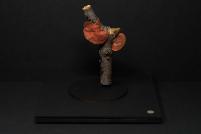
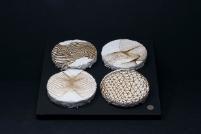
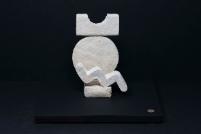
By blurring the boundaries between the practices of making and growing we are invited to interrogate sharp distinctions and hierarchies between humans and non-humans, culture and nature, artificial and organic.
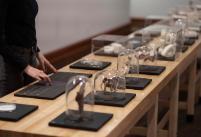
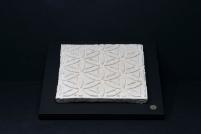
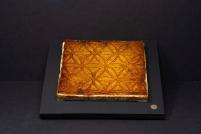
I examine the ways in which all material bodies are intertwined and constantly giving form to each other through pressure, friction, breath, growth, decay and ongoing material transformations by which all forms emerge.
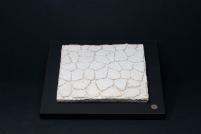
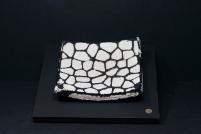
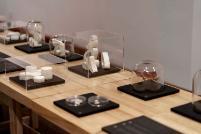
In times of ecological unraveling, Human-Nature Entanglements: Explorations in Creativity Beyond Human looks into biodesign as a creative space to reimagine humans’ relationship with nature.
view Isabel's full website of interspecies creativity with additional photos and videos here
Embodied Testimonio Methodology
Chell Parkins, Ed.D. candidate - Dance Education
Experiences of CAP teaching artists at Ballet Hispánico engaged in culturally relevant dance teaching practices with Latinx populations
This dissertation explores the experiences of Teaching Artists at Ballet Hispánico engaged with culturally relevant and sustaining dance teaching practices in Latinx populations through interviews, observations, and embodied testimonio methodologies. Despite Latinx Peoples representing the largest growing minority population in America today, representing more than 27% of American public school students and nearly 41% of students in New York City public schools, little research exists regarding culturally relevant and sustaining dance pedagogy for Latinx populations. Clandinin (2016) describes narrative inquiry as a process of living, telling, retelling, and reliving with a humanist theoretical perspective that values how individuals use storytelling to share and make meaning of their lives. With this in mind, I plan on utilizing fictionalized writing and video as modes of data analysis and presentation to share the educational stories of my participants. I draw on Latina Feminism to combine theories of the flesh that reclaim embodied knowledge with testimonios which are Latina counter-narratives to oppressive paradigms, creating an embodied testimonio methodology that intertwines various modalities to share testimonios including poetry, journal writing, imagery, music, and dance, drawing connections between these modes through video editing. This video example shares my personal embodied testimonio, reflecting on my positionality as I explore this methodology while conducting participant interviews and reviewing participants’ embodied testimonio data.
Clandinin, D. J. (2016). Engaging in narrative inquiry. Routledge.
"Despite Latinx Peoples representing the largest growing minority population in America today...little research exists regarding culturally relevant and sustaining dance pedagogy for Latinx populations."
Portraiture Methodology
Susan Pope, Ed.D candidate - Dance Education
"Portraiture is an embodied way of writing."
Standards for Justice: Duet Dialogues
Joan Finkelstein, Ed.D candidate, Dance Education
Context: Model of nesting dolls
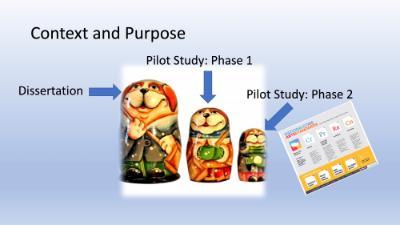
The relationship of this project to my dissertation is like Russian nesting dolls. My dissertation — the largest doll — sparked by our current polarized racial discourse, will investigate the intended, textual, and perceived cultural messages in our national, NYS and NYC dance standards via Interviews with the writers, discussion circles with teachers, and content analysis of the texts using a critical race theory lens.
Last spring, I conducted phase 1 of an IRB-approved pilot study on just 2nd grade creating and performing, testing the text analysis and discussion circle methods — which revealed a Western bias in the standards and divergences from teachers’ core values. That’s the middle size doll.
This ABR project, approved by the IRB as a phase 2 of my pilot study, is the smallest doll. I narrowed my focus further to the Enduring Understandings in the National Core Arts Standards, inviting four of my TC dance ed colleagues to unpack and reimagine one EU of their choice in individual Zoom dialogues. My research question: If we were to collaboratively as a dance educator community reimagine and rewrite the standards from a social justice perspective, what would that look like?
Embodied Protocol
These duet conversations used arts-based embodied modalities, such as call and response self-identifications to music. We also read all 11 EUs out loud in call and response, engaging sight, hearing, and speaking to deepen meaning; and we collaboratively analyzed and rephrased their chosen EU, taking real-time notes via Zoom screen share.
The Four EUs
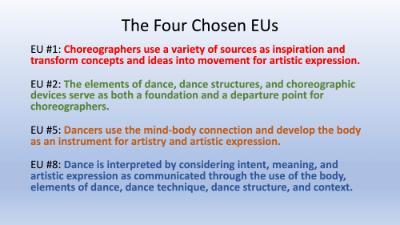
Emergent themes
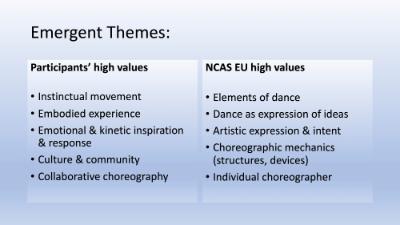
As in Phase 1 of the pilot, my dialogue partners’ work products – which I coded in vivo via Quirkos – revealed gaps between their high values and the standards. Their rephrased EUs serve as potential counter-narratives to the current standards text. I plan to shape my Spring 2022 Praxis Project on the modalities used in this project to collect more such teacher-generated counter-narratives.
References
Krippendorf, K. (2019). Content analysis. Thousand Oaks, CA: SAGE.
Levy, P. (2017). Research Design. Chapter 7 – Arts-Based Research Design pp 191-223. Guilford: New York.
Levy, P. (2017). Research Design. Chapter 8 Community Based Participatory Research Design. Guilford: New York. P. 224-254.
Rogers, D., Frellick, P. & Babinski, L. (2002). In Bagley, C. & Cancienne, M. Eds. Dancing the Data. Chapter 4 staging a study – performing the personal and professional struggles of beginning teachers pp 53-69. Peter Lang: New York.
Saldaña, J. (2016). The coding manual for qualitative researchers. 3rd Ed. Thousand Oaks, CA: SAGE. Kindle edition.
Snowber C. (2018). Living, Moving and Dancing Ed. P. Leavy Handbook of Arts-Based Research P. 247 – 266. Guilford: New York.
Snowber, C. 2010 The Zen of Laundry. https://www.youtube.com/watch?v=j7kz8yyzrCM
"If we were to collaboratively as a dance educator community reimagine and rewrite the standards from a social justice perspective, what would that look like?
The film you are about to see, an embodied poetic ode in tribute to my duet participants, is an attempt to bring you into this journey."
Student Research
Jihae (Jay) Cha's research centers on the role of education, particularly teachers, in promoting social cohesion among children and youth in conflict-affected countries. In her research, Jihae employs child-friendly visual methodologies to further explore refugee children's perceptions of peace, social cohesion, and resilience in both camp and refugee settings.
Jihyeon (Jessica) Lee's research aims to use Instagram as a pedagogical and methodological tool to interrupt and destabilize the dominant "at-risk" discourse surrounding youth's engagement in physical culture. Her particular focus is on investigating ethnic minority immigrant girls' perceptions of physical culture through social media.
Tara Schwitzman uses visual and spatial methodologies to think more deeply about what it means to resist in a capitalist society. In particular, she is interested in how public spaces influence the ways in which we see certain images as political and how images politicize public spaces.
Sarah van den Berg's visual research explores the aesthetics of curriculum and learning environments. She's interested in using visual methods to understand how various communities and individuals imagine the purposes and possibilities of education.
Ilya Benjamin Washington is the Founding Creative Director of #Wearewelcomehere. His visual research explores the everyday disruption of space by ordinary people historically threatened with physical or symbolic displacement.
Sheldon Sucre: “Movements for Social Justice: Reconceptualizing the self and social responsibility”
Brittany Kenyon (Curriculum and Teaching Program): “Children’s perspectives of a town on the edge”
Azsaneé Truss (MASCLab): “ Multimodal Monthly: The YPAR Edition”
Zhenzhen Qi (Art Education program): “Digital Interactivity: A lesson plan, a workshop & a video game on how not to be looped”
Katie Newhouse (Curriculum & Teaching program): “Small space, Big moments: Restricted educational programs as disabling sites of possibilities”
Emily Bailin-Wells (MASCLab): “The role of ‘Finstas’ (Fake Instagram Accounts) in youth self-expression and digital participation”
Joe Riina-Ferrie (Educational Video Center): “Lingering Traces of Youth Media Engagement”
Alumni
Mara Simon's research explores the experiences of ethnic minority female physical education teachers from a critical perspective. She does this through a combination of narrative inquiry, life history, and visual methodology.
Patrick Keegan's (PhD, Social Studies Education, 2017) research explores how immigrant youth construct civic belonging by attending to their everyday enactments of citizenship across the contexts of school, neighborhood, and home. In doing this, he uses critical visual methodologies. The title of his dissertation is: Places of Civic Belonging among Transnational Youth.